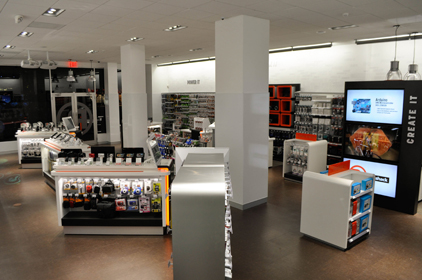
|
| Organized retail crime gangs often target consumer electronics stores with high price tag items easily fenced. In addition to better law enforcement and security video, some stores now have lock-down displays which make products attractive to sampling customers but difficult to steal. Pictured: RadioShack's new concept store at 2268 Broadway in New York City has newly configured displays highlighting in-demand brands like Apple, HTC and Samsung, and carriers like AT&T and Verizon. Photo courtesy of PRNewsFoto/RadioShack Corporation |
Savvy, confident organized retail crime gangs -- who steal billions of dollars worth of merchandise each year only to sell that merchandise online or at brick-and-mortar or fencing locations – continue to test retailers. The National Retail Federation’s ninth annual Organized Retail Crime (ORC) survey found that 93.5 percent of retailers say they have been a victim of organized retail crime in the past year, down slightly from 96 percent in 2012. For the past three years, more than 90 percent of the retailers surveyed have admitted to being victims of ORC. Equally disturbing: Eight in 10 (81.3 percent) believe that ORC activity in general in the United States has increased over the past three years.
For the first time, NRF asked the senior loss prevention executives about their experience with store credit merchandise/gift card fraud. And the results are troubling. When asked specifically if they’ve experienced boosters who return stolen merchandise without a receipt for the sole purpose of receiving store credit via a gift card, who then turn around and sell that merchandise credit for cash to secondary markets that include kiosks, pawn shops and check cashing stores, 78 percent said they have experienced this.
One distressing trend in organized crime activity is the propensity for thieves to resort to violence to avoid being apprehended, putting store personnel, law enforcement and customers at risk. According to the survey, retailers say on average two in 10 (18.3 percent) apprehensions lead to some level of violence, up from 15 percent last year and 13 percent in 2011.
Thanks to organized methods of communication between retailers and law enforcement, awareness among law enforcement officials is at an all-time high. According to the survey, nearly half (48 percent) of retailers say they believe law enforcement understands the complexity and severity of ORC, up from 40 percent last year. Nearly six in 10 (58 percent) believe top management at their organization understands the severity of ORC, up from 54.4 percent last year.
Top Cities for Organized Retail Crime Activity
The top 10 locations that retailers say have the most criminal activity are (in alphabetical order):
- Atlanta
- Baltimore
- Chicago
- Dallas
- Houston
- Los Angeles
- Miami
- New York
- Northern New Jersey
- San Francisco/Oakland
Source: NRF
Organized retail crime must be addressed through Federal legislation by amending the Federal Criminal Code, contends the NRF.


